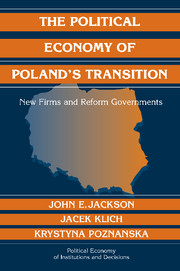Book contents
- Frontmatter
- Contents
- List of Tables
- List of Figures
- Acknowledgments
- List of Abbreviations
- 1 Why Poland?
- 2 The Dynamics of the Polish Political Economy, 1990–1997
- 3 Creative Destruction and Economic Transition
- 4 The Social and Distributional Costs of Transition
- 5 Individual Attitudes and Voting
- 6 De Novo Job Creation and Election Returns
- 7 Liberal Economic Interests and Seat Allocations
- 8 The Political Economy after 1997
- 9 The Political Economy of Transition: Why Poland?
- Appendix A Assessing Measures of New and Small Firms in Poland
- References
- Index
- Titles in the series
8 - The Political Economy after 1997
Published online by Cambridge University Press: 07 August 2009
- Frontmatter
- Contents
- List of Tables
- List of Figures
- Acknowledgments
- List of Abbreviations
- 1 Why Poland?
- 2 The Dynamics of the Polish Political Economy, 1990–1997
- 3 Creative Destruction and Economic Transition
- 4 The Social and Distributional Costs of Transition
- 5 Individual Attitudes and Voting
- 6 De Novo Job Creation and Election Returns
- 7 Liberal Economic Interests and Seat Allocations
- 8 The Political Economy after 1997
- 9 The Political Economy of Transition: Why Poland?
- Appendix A Assessing Measures of New and Small Firms in Poland
- References
- Index
- Titles in the series
Summary
Much transpired in Poland's politics and economy after 1997. Economic growth slowed and unemployment increased dramatically. The rightist coalition of church and trade-union leaders that dominated the 1997 election disintegrated to the point it could not gain enough votes to be seated in the parliament after the 2001 elections. A casual inspection might suggest that these events contradict our previous analysis and conclusions, and this might be true. The detailed economic data that form the basis for the preceding chapters are not available for the years after 1997, preventing a careful analysis of the four years following 1997 and a rigorous testing of the propositions developed earlier. We use what data are available to explore several explanations for what transpired between 1997 and 2001. The goal is to offer some insight into whether the conclusions we reached about the period from 1990 to 1997 are only applicable for that stage of the transition or whether the model we develop is consistent with this later period as well. After a brief summary of the main economic and political events, we examine the economic changes, compare the voting patterns in the 2001 with the votes cast in 1997, and then evaluate the model and its usefulness in understanding the later stages of the Polish transformation.
THE ECONOMY
Table 8.1 shows the level of real GDP relative to 1989, the unemployment rate, and the change in GDP for the period 1989 to 2001.
- Type
- Chapter
- Information
- The Political Economy of Poland's TransitionNew Firms and Reform Governments, pp. 202 - 229Publisher: Cambridge University PressPrint publication year: 2005



